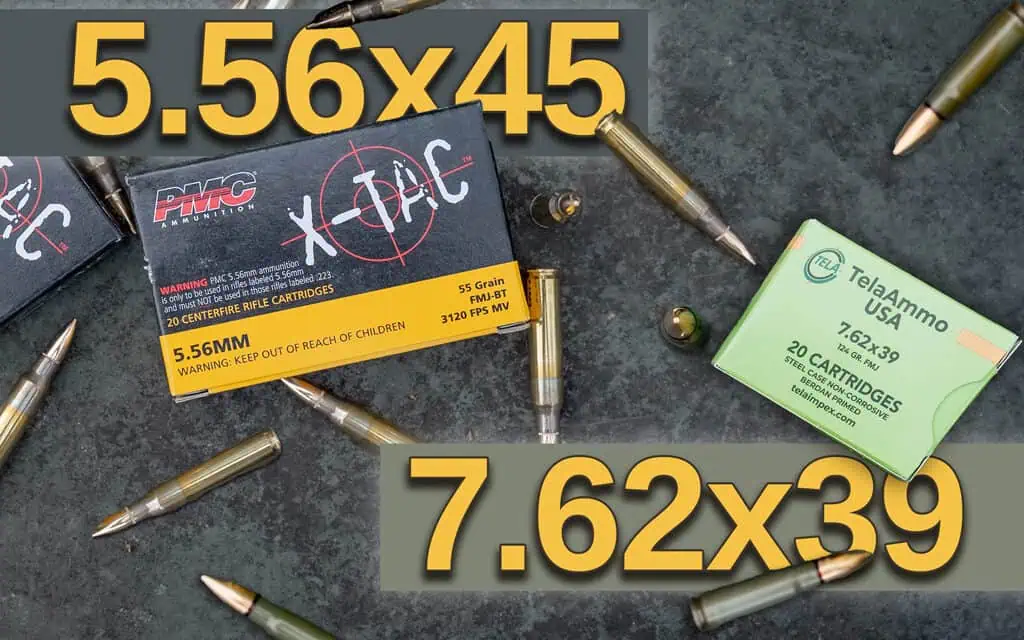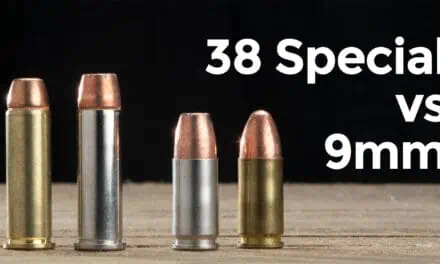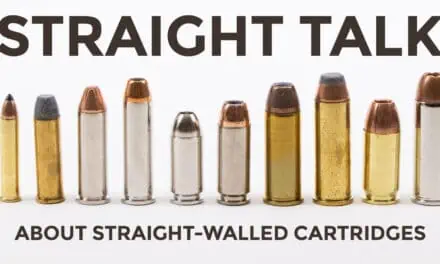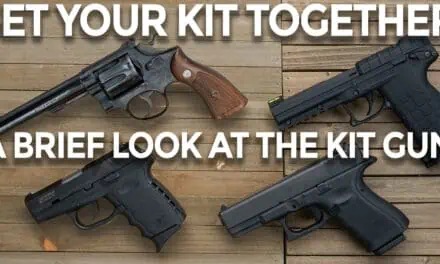7.62x39mm vs. 5.56x45mm: AK or AR?
An article like this usually kicks off with some long, drawn-out yak about Russia, the United States, NATO, the Iron Curtain, and so on, and so on.
I don’t want to write that. You don’t want to read it, either, because you obviously didn’t come to AmmoMan.com because you want a geopolitical history lesson. You just want to know how these cartridges stack up against one another.
So let’s jump right into it: an exhaustive comparison of the 7.62x39mm vs the 5.56x45mm cartridge.
Quick Hit: 7.62×39 vs 5.56 – What’s the Difference?
7.62×39 is a heavier bullet – typically about twice the weight of a 5.56×45 bullet. While neither caliber is ideal for true long distance shooting, the 5.56 does give you a flatter trajectory at a lower cost per round than 7.62×39. Both calibers can be used to hunt medium-sized game in North America like whitetail deer, though you might prefer to haul an AR-15 around the woods over an AK-47, which is about 4 pounds heavier.
Now, we’ll dig into the details of these two great rifle calibers.
7.62×39 vs. 5.56×45: Physical Dimensions
The greatest difference between the 7.62x39mm and 5.56x45mm (hereafter referred to as “7.62” and “5.56”) are their bullet diameters. The first number in each round’s name refers to its bullet diameter, in millimeters (the second number indicates case length). In other words, we’re comparing the world’s most popular .30 caliber cartridge to its second most popular .22 caliber round (22 LR being the first).
| 7.62x39 | 5.56x45 | |
|---|---|---|
| Bullet diameter | 0.309 - 0.311 in | 0.224 in |
| Land diameter | 0.300 in | 0.219 in |
| Neck diameter | 0.339 in | 0.253 in |
| Shoulder diameter | 0.396 in | 0.354 in |
| Base diameter | 0.447 in | 0.377 in |
| Rim diameter | 0.447 in | 0.378 in |
| Case length | 1.524 in | 1.760 in |
| Overall length | 2.205 in | 2.260 in |
| Case capacity | 35.6 gr H2O | 28.5 gr H2O |
| Max pressure | 45,010 psi | 55,114 psi |
The 7.62’s wider bullet has multiple implications for its performance. A wider bullet is usually a heavier bullet, which explains why the 7.62 bullet is typically more than twice as massive as a 5.56’s. Together, the 7.62 cartridge’s (A) heavier bullet and (B) not substantially larger overall size account for its lower muzzle velocity (i.e. the rate at which the bullet exits the muzzle, as measured in feet per second; fps).
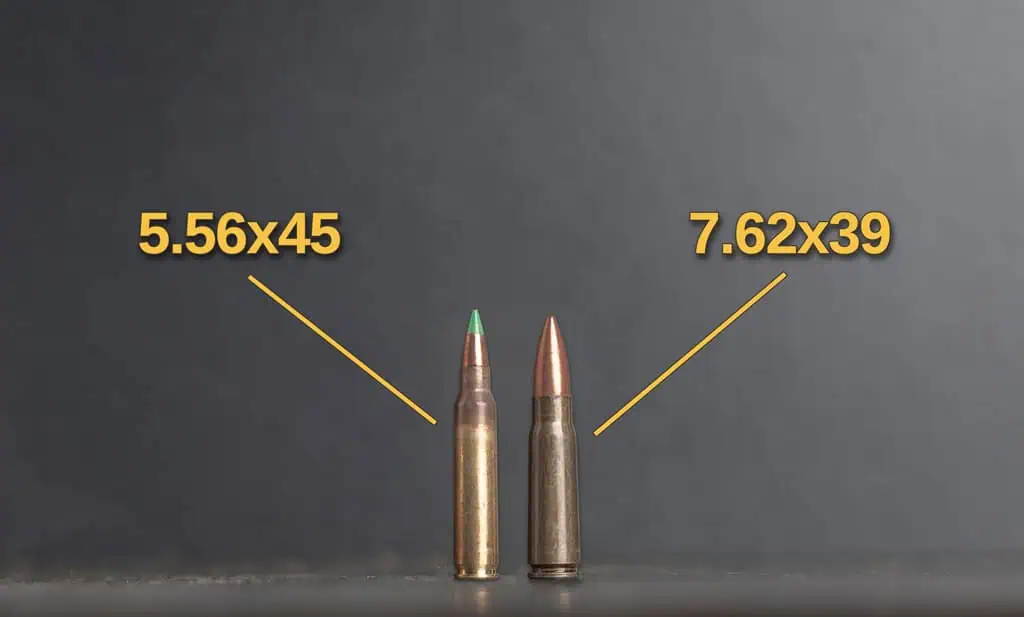
5.56×45 and 7.62×39 side by side.
In other words: 7.62 equals heavier, slower bullet; 5.56 equals lighter, faster bullet.
Being the larger cartridge, the 7.62 also has greater case capacity: i.e. more room for the explosive propellant it needs in order to launch so massive a bullet. 5.56×45 ammo is rated to withstand a higher chamber pressure, however, meaning it can put relatively more “oomph” behind its bullet.
7.62 vs 5.56: Size Matters
We’ll see how that bears on ballistic performance momentarily. But first, a few notes on these rounds’ physical dimensions:
1. It’s difficult to conceptualize by looking at the numbers alone, but the 7.62 case exhibits a steeper taper than the 5.56’s. It becomes substantially narrower from base to mouth, which accounts for the AK-47 magazine’s curvier shape.
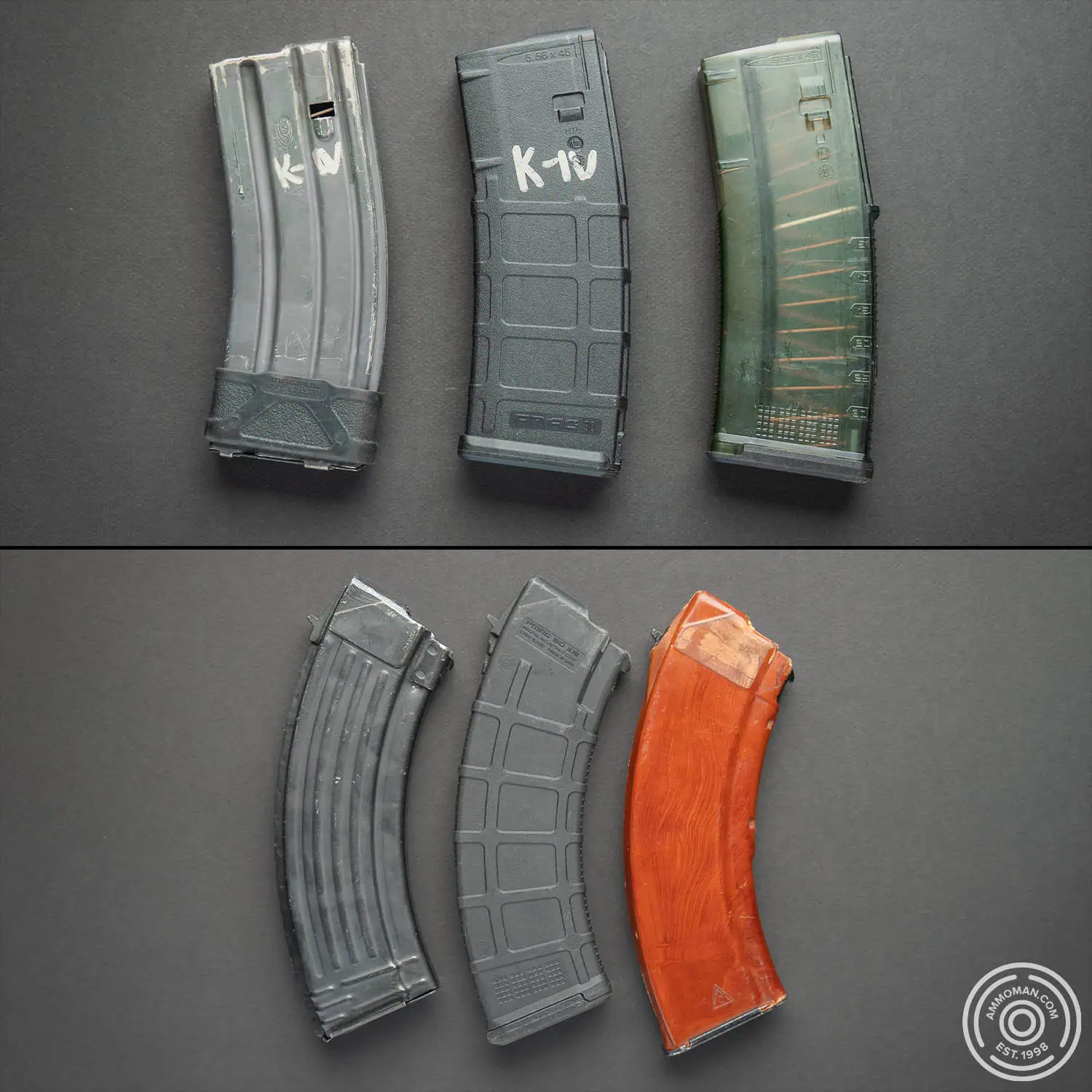
(Top) 5.56×45 magazines (Bottom) 7.62×39 magazines
2. The 7.62 is the larger and heavier cartridge: ~250 grains, as opposed to the 5.56’s ~190 grains. This lines up with the sensibilities of the largest armies that have used either round. The Soviets expected to use their 7.62 primarily in and around Russia (at the time of its design, at least), whereas America adopted an intermediate combat cartridge that would be easier to transport across the globe.
3. It doesn’t really bear on the cartridge comparison at hand, but the massively popular 223 Remington is essentially the commercial variant of the 5.56. In fact, 223 Rem is so similar that it is safe and normal to fire it in a 5.56 rifle.
7.62×39 vs. 5.56×45 Ballistics
| Cartridge | Manufacturer | SKU | Bullet Weight (gr) | Bullet Type | Muzzle Velocity (fps) | Barrel Length (in) | G1 BC |
|---|---|---|---|---|---|---|---|
| 7.62x39 | PMC | 7.62A | 123 | FMJ | 2350 | 20 | 0.266 |
| 7.62x39 | Federal Premium | A76239A | 124 | FMJ | 2350 | 20 | 0.298 |
| 7.62x39 | Remington | 29125 | 125 | PSP | 2365 | 20 | 0.267 |
| 5.56x45 | PMC | 5.56X | 55 | FMJBT | 3270 | 20 | 0.243 |
| 5.56x45 | Winchester | USA855125 | 62 | FMJ M855 | 3060 | 20 | 0.344 |
| 5.56x45 | Sellier & Bellot | SB556C | 77 | BTHP | 2825 | 20 | 0.376 |
A perfectly apples-to-apples comparison of two such dissimilar rounds is nigh impossible. For example, the 7.62’s bullet usually weighs 124 grains, give or take a grain (with some outliers, such as the Hornady Subsonic 255 grain load), whereas 5.56 bullets usually weigh 55 (the most popular), 62, or 77 grains.
Barrel Length
Barrel length is another barrier to truly analogous comparison. The standard AK-47 barrel is 16.3”. The most common AR-15 barrel length is 16”, which isn’t significantly different. But despite this, ammo manufacturers commonly use 20” test barrels to record muzzle velocities for these two rounds. Our own data reflects that fact.
A longer barrel typically produces a higher muzzle velocity (as it gives exploding propellant gasses more time to push the bullet), which is why the following data probably don’t reflect the sort of performance you should expect if you were to conduct your own real-world comparison.
Without losing sight of our comparison’s limitations, it’s interesting to note some glaring differences between these rounds’ ballistic performance. Most significantly, the 5.56 exhibits a much flatter trajectory. The three 5.56 rounds’ bullets dropped an average of 46.2” at 500 yards, whereas the three 7.62 rounds’ bullets dropped 91.6” – around 50% more. You can also plainly see how much higher the 7.62’s bullets have to rise above the bore line before striking a 200-yard zero: about 1.4” higher, on average.
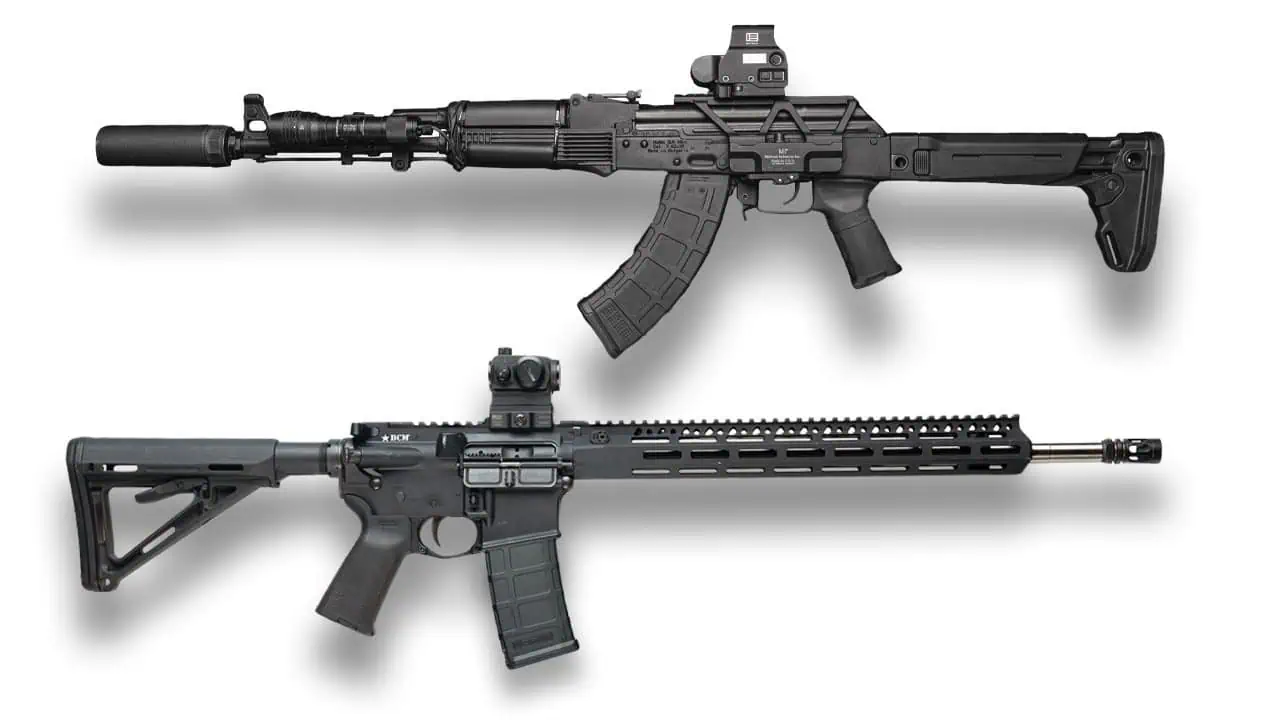
AK-107 (Top) and AR-15 (Bottom)
That hardly makes 7.62×39 ammunition inaccurate, though. Its heavier bullet’s higher inertia grants it greater resilience to wind deflection, which can certainly aid long-range marksmanship. That said, the 7.62 bullet must rise higher above the bore line before colliding with its target, which makes things increasingly complicated the farther out you aim. Neither round is intended for long-distance shooting, of course, although most shooters would find the .22 cal round’s flatter trajectory easier to work with all the same.
If you’re interested in comparing the AR vs AK rifles, check out this piece we did on the AK-47 vs. the AR-15.
7.62×39 vs. 5.56×45: Stopping Power
Both of these rounds were designed for the same purpose: neutralizing whomever they’re fired at. To argue that one does its job better than the other would be very silly, especially considering how crucial marksmanship is to either one’s performance. A perfect shot with a 7.62 is more effective than a missed shot with any other rifle, which renders any comparison of “stopping power” an exercise in splitting hairs.
But let’s split hairs regardless. The 7.62 can be argued to have substantially greater wounding characteristics for three key reasons:
1. The 7.62 bullet hits harder. Our three 7.62 comparison rounds’ average muzzle energy equals 1,528 ft lbs – around 16% more powerful than the average of the three 5.56 rounds.
2. The 7.62 bullet is wider. The 7.62 punches a 38% wider hole through its target. ‘Nuff said.
3. The 7.62 bullet has intrinsically better capacity for penetration. Sectional density (SD) is a measure of how efficiently a bullet penetrates flesh, and is solely determined by bullet weight and diameter. It doesn’t predict how deeply a bullet can penetrate with any reliability or precision, though it is illustrative. To that end, the 7.62 typically exhibits the higher SD: 0.186 for a 123 grain bullet. In contrast, the 5.56 usually has an SD of 0.157 (55 grains), 0.177 (62 grains), or 0.219 (77 grains).
7.62×39 vs. 5.56×45: Recoil
The 7.62 also hits harder downrange. For context, consider this table illustrating the maximum distances our comparison cartridges will deliver at least 1,000 ft lbs of kinetic energy to, in yards. Interestingly enough, the 7.62 carries 1,000 ft lbs of energy around 16% farther – the same advantage its muzzle energy has over the 5.56’s.
| Farthest Distance at Which Bullet Retains at Least 1,000 ft lbs of Energy (yds) | |
|---|---|
| 7.62x39 123gr FMJ | 146 |
| 7.62x39 124gr FMJ | 167 |
| 7.62x39 125gr PSP | 157 |
| 5.56x45 55gr PSP | 100 |
| 5.56x45 62gr FMJ M855 | 133 |
| 5.56x45 77gr BTHP | 171 |
Lighter recoil is always preferable. It makes firing a gun more comfortable, and causes less of the upward jerking motion known as “muzzle flip” which increases the length of time you have to spend restoring your aim on the target.
Energy On Target
We can easily calculate each aforementioned cartridge’s free recoil energy. Let’s assume every round contains 24 grains of propellant (not perfectly accurate, but a reasonably close estimation). Let’s also assume we’re firing two 6.5 lb rifles. With that, we only need to consider each round’s bullet weight and muzzle velocity as we calculate its respective recoil energy.
| Recoil Energy (ft lbs) | |
|---|---|
| 7.62x39 123gr FMJ | 8.2 |
| 7.62x39 124gr FMJ | 8.3 |
| 7.62x39 125gr PSP | 8.4 |
| 5.56x45 55gr PSP | 4.4 |
| 5.56x45 62gr FMJ M855 | 4.7 |
| 5.56x45 77gr BTHP | 5.6 |
As you might have rightly surmised, the 5.56 has less recoil to show for its weaker striking energy. It has almost 60% less recoil in this instance.
But 7.62 rifles rarely weigh 6.5 lbs. An AK-47 is around 4 lbs heavier than that, and therefore allows a 124 grain load to generate a mere 5.1 ft lbs of recoil – less than a conventional 6.5 lb AR-15 firing a 77 grain projectile.
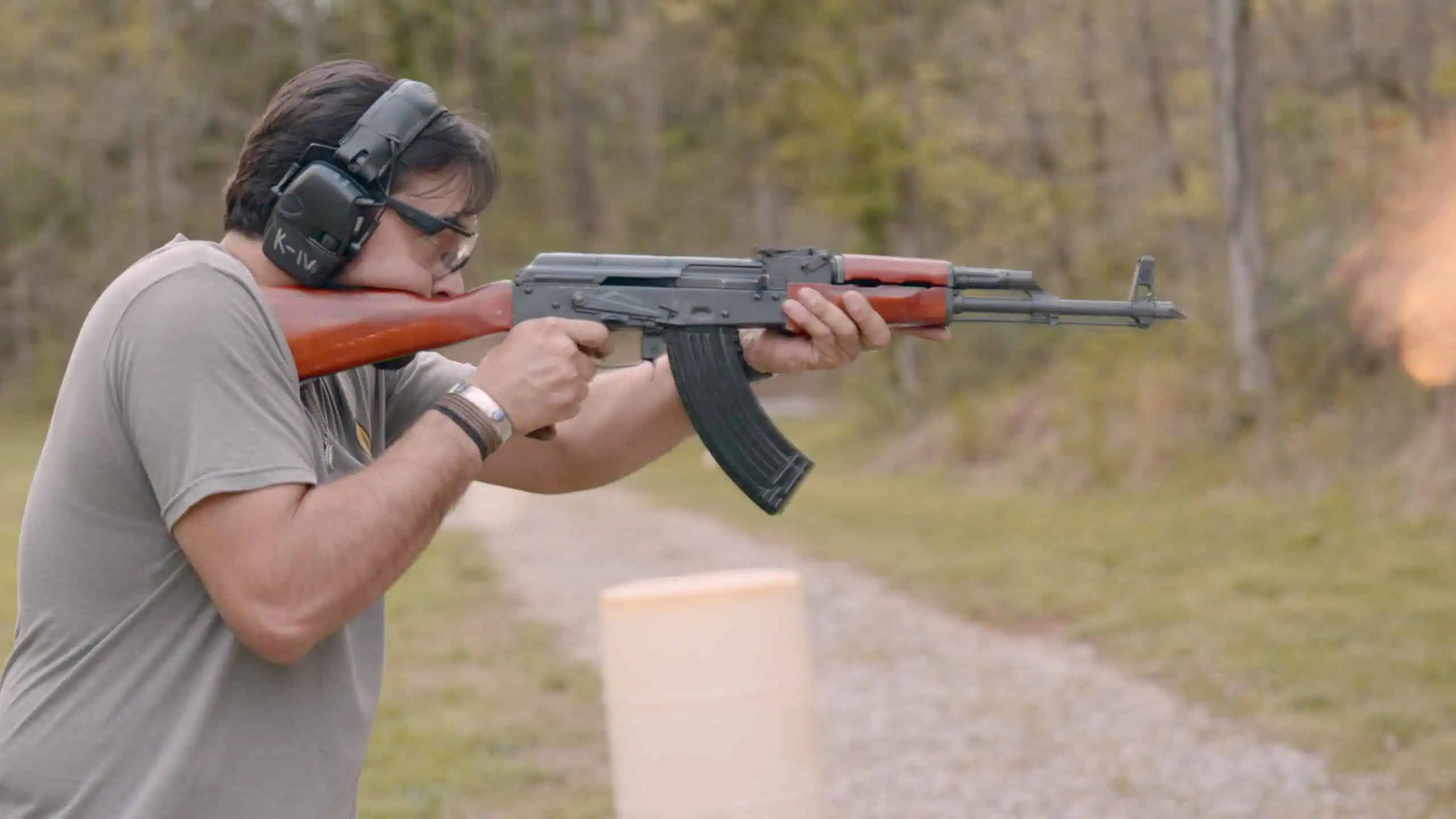
7.62 has more “felt” recoil compared to 5.56
All things being equal, the 5.56 is the lighter-recoiling cartridge. Factoring in an AK’s more formidable (and less fun to carry) heft, the two rounds can share practically identical recoil. And just to be sure: none of these rounds generates uncomfortable or uncontrollable recoil.
7.62×39 vs. 5.56×45: Availability and Cost
7.62 ammo used to be much more freely available in the U.S. It became less so after the Biden administration banned the import of ammo from Russia, where the majority of cheap steel-cased 7.62 is made.
Is it impossible to find 7.62 anymore? Not at all. It’s just a bit harder to come by the steel-cased stuff. (Cheap Russian-made steel-cased 223 Rem also became a lot scarcer after the ban, so it sort of balances out.)
That aside, 7.62 typically costs more. This makes sense, as more metal is required to manufacture the larger cartridge, and more energy is expended fabricating and transporting it.
This is by no means a scientific comparison, but at the time of writing we are offering a 1,000-round case of CBC brass-cased 5.56 for sale for $425 (42.5¢ per round). To contrast, we are also offering an 840-round case of Igman brass-cased 7.62 for $515 (18.8¢ more expensive per round).
That’s only one example. Truth be told, a savvy ammo shopper can probably find much cheaper 7.62 (so long as they’re not overly hung up on quality). But as a general rule, you can expect to spend more firing 7.62.
It’s important to note that you’ll enjoy less ammo variety if you choose 7.62 over 5.56. The vast majority of 7.62 is loaded with FMJ bullets, which are perfect for conventional target practice but suboptimal for every other pursuit. Conversely, the 5.56 (and the interchangeable 223 Rem even more so) is loaded with a greater variety of bullets, making it easy-peasy to find ammo designed for long-distance shooting, home defense, and hunting small or medium game.
Conclusion
The 5.56 shoots flatter, recoils lighter, and sells cheaper. The 7.62 hits harder. But at the end of the day, both cartridges do fine at their intended purpose: rapidly engaging targets at ranges out to around 300 yards. If you prefer either one for any reason, then it’s necessarily your better choice.
For many shooters it all boils down to the rifle. The AK-47 is an alluring, almost alien-looking piece of engineering which is famously dependable after being mistreated. The AR-15 is America’s rifle of choice, and endlessly customizable even if you aren’t an experienced gunsmith. Truly, the best answer to “7.62 or 5.56?”

